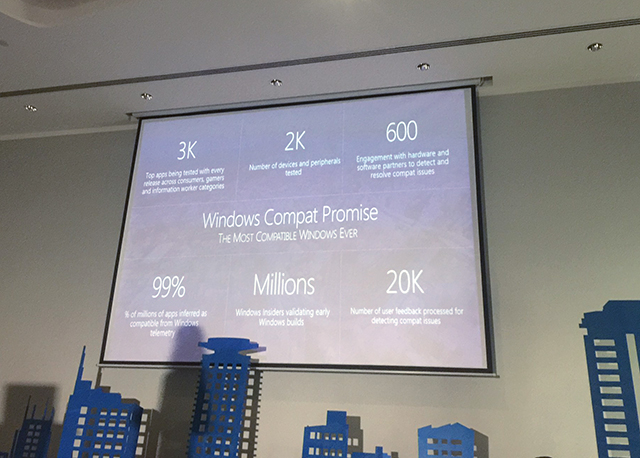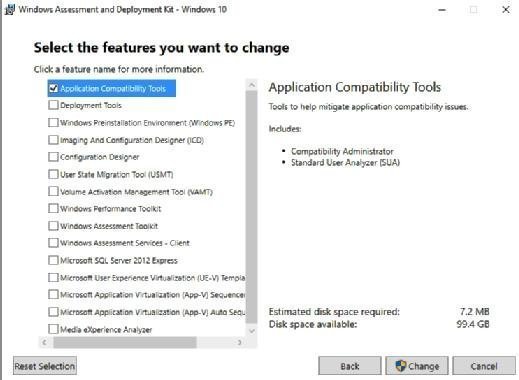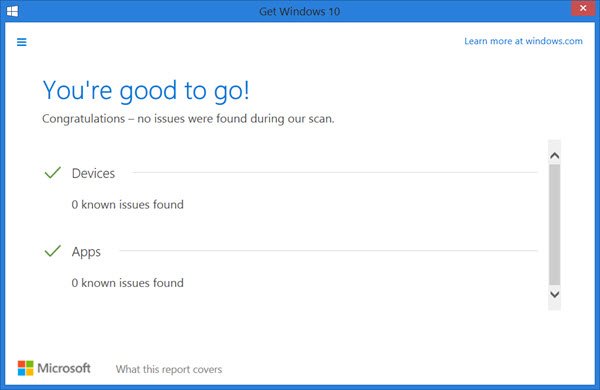In addition to increased reliability, the supported processors increase security capabilities at the chip level. These processors provide virtualization extensions and virtualization performance improvements. Windows 11 supports virtualization-based security which enables several security capabilities, including memory integrity, also known as hypervisor-protected code integrity . HVCI disables dynamic code injection into the Windows kernel. HVCI also provides driver control and ensures that all drivers loaded meet a policy of allowed drivers set by Microsoft and the user.
The United States Department of Defense requires virtualization-based security on Windows 10 for their devices. In partnership with our OEM and silicon partners, we will be enabling VBS and HVCI on most new PCs over this next year. And we will continue to seek opportunities to expand VBS across more systems over time. Windows 11 continues our strong commitment to compatibility. This means that devices can upgrade to Windows 11 and critical apps and devices will simply work.
Raising the Windows 11 minimum system requirements enables us to better support apps and hardware for drivers and devices. Feedback also shows us that unsupported hardware is more likely to have older drivers that are incompatible with new OS features such as VBS. Supported hardware also comes with modern drivers, which helps ensure not only the reliability we mentioned earlier, but also great hardware compatibility.
Determine if your computer adheres to Windows 10 System Requirements. Your processor must be a minimum of one GHz or faster and support SSE2, NX and PAE. If your computer does not support these, an installation of Windows 10 will not be possible. Additionally, make sure your device drivers are all updated. Talk to a hardware technician to determine if you should upgrade components. Don't forget to perform a manual run of the Windows 10 Compatibility Appraiser if you make any alterations to your system.
The new Windows 11 is here and it surely comes with a host of interesting features. The latest operating system from Microsoft brings you new visual changes, compatibility with Android, interesting gaming-related features, and more. The company has also revealed that a vast majority of PC or laptop available in the market will be compatible with Windows 11. The brand has also released a list of minimum requirements and processors that support the latest operating system. That being said, if you want to know whether your Windows 10-powered laptop or PC is compatible with Windows 11, there is a simple way to do it. In this article, we are going to show a step-by-step guide of how you can check for Windows 11 compatibility with your laptop or PC.
You can efficiently use Windows 10 software compatibility checker on your Windows PC/laptop. It will help you to understand the need for software and hardware for Windows 10. Make sure you read it entirely before downloading any Windows 10 update. Do share this article with your friends and help them to know Windows 10 requirements in their PC/Laptops. Incuboy_mae_5071 said that NX requires VT-d/Vt-x, but I'm reasonably sure that's incorrect.
After some intense effort in August to get the Upgrade of Windows 10 on a pair of identical Acer Aspire One's with Intel Atom N455 1.6GHz and a complete surrender I decided to try again this week. Following directions from a recent article I can't find anymore I installed CPUID (CPU-Z) to check compatibility. The article explained that the designation of NX came under another heading in the information supplied in that little gem.
I was indeed lacking in VT-d/VT-x but I tried on the first Acer anyway and the install was successful. I found it helpful to delete and let the graphics driver reinstall after, as I noticed some glitching. I also had some remnants of uninstalled Microsoft Security Essentials that were causing a maxed cpu issue but I worked through that and ever since I've been happy.
On the second Acer I had trouble with the 10 installer saying my processor wasn't NX compatible and found this super article. I didn't used the steps outlined because the comment by darran_5548 below, used opposite to his success worked . The upgrade advisor will also check whether any software, hardware, or drivers are installed on your PC or laptop. That is incompatible with the windows 10 compatibility checker and can cause a conflict.
For those who are using a PC that won't upgrade, and who aren't ready to transition to a new device, Windows 10 is the right choice. We will support Windows 10 through October 14, 2025 and we recently announced that the next feature update to Windows 10 is coming later this year. Whatever you decide, we are committed to supporting you and offering choice in your computing journey. If you want to see the full Windows 11 minimum system requirements, you can visit this page. If you have had the same installation for a long time, you might need to analyze and repair the current setup to fix missing or damaged files.
Otherwise, during the upgrade process, the chances of running into issues will be high. However, if you plan to proceed with a clean installation using a bootable USB flash drive, then you can't skip this suggestion since the previous installation will be erased during the process. You may run a windows 10 compatibility checker by following the steps outlined in this article. After testing for the windows 10 compatibility checker and confirming that your PC meets the system and hardware specifications, you will update it to the new operating system.
Please share any other methods for deciding if Windows 10 is compatible with older computers. Finally, on 14th January 2020, Microsoft end support for its most popular OS Windows 7 and suggest to upgrade the latest windows 10. And now almost every new laptop or desktop comes with windows 10 preinstalled.
I hope this article may help find the best way to Windows 11 compatibility check to know if your Windows 10 laptop or desktop is eligible for the upgrade. You can do a windows compatibility check online, and it's a new way to connect with more people around the world right from your desktop with Microsoft terms. You can call or chat for free no matter what device you're on. Once you complete the steps, the tool will download the files and create an installation media, which you can then use to upgrade a compatible computer to Windows 11. After you complete the steps, repeat the instructions to back up the files on the remaining accounts . In addition to making a copy of your files, it's also recommended to create a list of the installed programs with their respective product keys to know what you need to reinstall in the new setup.
If you usually do not sync passwords and bookmarks with an online service, this is a good time to export your browser credentials and links. We will start by creating a package for Windows 10 compatibility check. The source of this package must be the Windows 10 installation media. The deployment option and command line is important here.
If they are not set correctly you'll end up sending the complete installation media (including Install.wim) to the computers only for a compatibility check which is not really effective. Using our proposed methods, you'll be using about 250mb on the client drive instead of 5gb. Following extensive testing, Microsoft's compatibility checker app is finally out of beta and now available to anyone who wants to try it out. It is important to download updated drivers from various hardware manufacturers' websites after installing Windows 10. Updating drivers can ensure that Windows 10 runs smoothly and error-free.
The program returns one of three possible windows after the compatibility check runs. I'm running Enterprise on my production PC and have flagged this as an error or problem with Microsoft via its Feedback Hub. With its machine learning technology, Microsoft has determined further devices on which the Windows 11 update prompt should now appear automatically. The Redmond-based software company has not revealed any additional information on which exact PC configurations are included in this third group. However, manually triggering the Windows 11 update, which is how many tech enthusiasts probably installed Windows 11 in the past weeks, is no longer necessary on these PCs.
Users can simply check the regular Windows Update application in order to verify whether the Windows 11 upgrade is ready to download on their respective device. After you complete the steps, the device should be able to boot from a USB installation media and pass the minimum system requirements check. For example, even though Windows 11 is available as a free optional update for Windows 10, the device must meet the new system requirements. Otherwise, you won't be able to proceed with the setup. You need to ensure that the Trusted Platform Module and Secure Boot are enabled on the computer. You also need to make sure the device has enough space and there are no problems before continuing with the upgrade.
Furthermore, you want to create a backup in the case you need to roll back, check the activation status, and create installation media. This version of the operating system allows software to use 64-bit addresses to access hardware and can therefore access much larger memory spaces. In order to run successfully on Windows bit, all drivers must have native 64-bit support. However, most 32-bit software applications can run within a Windows bit emulation layer. Once you've clicked on the option, it will list out any probable issues with the software, apps or drivers. If you find any such problem mentioned there, it means your system is not compatible with Windows 10 at present.
Uninstall the app and wait until the compatible version of the Windows for your PC is launched. Windows 10 may still work on your PC even if you download it while some issues are being shown, but it may not run smoothly and create some trouble for your system. It is better to wait therefore and get the better version of the software for your PC. Following the results of our testing, we are making a small number of additions to the compatible processor list , but otherwise will maintain the minimum system requirements as originally set. Microsoft has begun the process of rolling out hundreds of millions of free Windows 10 upgrades.
In addition to system requirements, you should also check software compatibility and driver compatibility. If you don't do the checks, once you start the upgrade, the Windows 10 installation process will be stopped when some errors and compatibility issues are found. Once installation has completed, your system will restart and boot into the Windows 10 desktop.
Microsoft 10 Compatibility Checker Installation of the Windows 10 operating system is now complete, but you still need to install updated drivers, applications and utilities for Windows 10. When planning for a Windows 10 migration, understanding your environment is the key. Luckily, Windows 10 setup comes with command line options which one of them is an excellent compatibility check (/Compat ScanOnly). This command can be used on a Windows 7,8 or 10 devices before a migration in order to see if those devices are Windows 10 compatible.
Using SCCM, we will run this Windows 10 compatibility check, return the results in the SCCM database and use this data to build a comprehensive report. This report can be used to detect and fix migration errors before the actual Windows 10 deployment. Because Windows 10 release date was very close to NI August 2015 software release date, August 2015 releases were not documented with respect to Windows 10 support. Based on testing after Windows 10 release, the following NI software packages are compatible with the listed versions of Windows bit and Windows bit.
As of 2016, all new versions and service pack updates of NI software document their compatibility with Windows 10 in their Readme files. If there is any question about the compatibility of a piece of software with the 64-bit versions of Windows and LabVIEW, please refer to the Readme for that release. After the download, double-click the ISO file and then double-click the setup.exe file. Click Next at the initial install screen to check for and download any updates to Windows 11. At the Ready to Install screen, you will see that Windows 11 will be installed and personal files and apps will be kept by default. After the installation completes, you will be prompted to restart your PC.
You are given the option to restart the machine immediately or wait for the 30-minute timer to end if you need time to save any open work. After your PC reboots, you can sign into Windows again. Once the final setup is complete, you are deposited at your new Windows 11 desktop. You can use thePC Health Check appto determine if your device is eligible to upgrade to Windows 11. Many PCs that are less than four years old will be able to upgrade to Windows 11.
They must be running the most current version of Windows 10 and meet the minimum hardware requirements. Either of these tools can provide you ample intelligence to determine if your PC is ready for Windows 11, with one caveat. Older PCs whose CPUs qualify under the processor requirement may include hardware-based TPM chips of version 1.3 or older . These CPUs can emulate TPM 2.0, so what looks like a failure to meet Windows 11 requirements at the hardware level can be offset in software. I will explain further in the section on the Windows 11 Compatibility Check script below.
After carefully analyzing the first generation of AMD Zen processors in partnership with AMD, together we concluded that there are no additions to the supported CPU list. We will be updating the PC Health Check app to identify the correct systems with the newly added Intel CPUs in the coming weeks before the tool is released for general availability. My PC says I am good to go, what I would really like to know though is as I am running Windows 7 SP1 and my scanner and Printer work fine in Windows 7. If I update to windows 10 will I be required to install new drivers for windows 10 Operating system, as a number of manufacturers will not be producing legacy device drivers. So the cost of updating to windows 10 although the OS is free may cost me in terms of having to purchase new hardware that is windows 10 compatible.
Sorry I have been unable to find a definitive answer from the product website. So, you need to first perform a Windows 10 compatibility check before a system update. This mainly aims to avoid troubles of downloading the OS and running the setup tool only to figure out whether obvious compatibility problems exist. Besides, Windows 10 compatibility test can give you a choice to consider solutions before upgrading to Windows 10 when some compatibility issues are found.
Most users choose to upgrade to the new system from Windows Vista/XP/7/8. One of the reasons is that your machine is not compatible with Windows 10. The software, apps, and drivers on your device don't work for the system. In particular, a bad driver can wreak havoc your system. The brand new Windows 11 is here, and it comes with the most amazing features.
The recent OS from Microsoft gets you new visual changes, compatibility with Android, interesting gaming-related qualities, and so on. If you don't know that your Windows 10 PC or laptop is eligible for Windows 11 upgrade or not, you need to do your PC health check-up tool produced by Microsoft. Still, if the app appears that your laptop or PC is not compatible, so you should wait. Because Microsoft has revealed system requirements, on that basis, you can check the eligibility of your Windows 10 based laptop or desktop. Furthermore, if you plan to upgrade with a clean installation, you will also need to make sure the computer can start from a USB flash drive. Current versions of all MOTU software products and hardware drivers available at motu.com/download appear to be compatible with Windows 11, although final compatibility testing is still on-going.
Microsoft has updated hardware requirements to make PCs more secure on Windows 11. Because of this, minimum hardware specs are stricter. So, before you install Windows 11, you'll first need to check to see if your PC's motherboard and processor are compatible with the new OS. According to the company's documentation, Windows 11 will require a minimum of a dual-core 64-bit processor, 4GB of RAM, and 64GB of storage as the minimum.





























